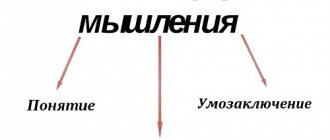Thinking is determined by a person’s needs, his interests, motives, tasks, goals, that is, a person’s thinking is purposeful in nature, associated with the needs and motivation of a particular individual.
A person’s individual thinking is directly related to his mind, but the concept of mind is broader: it includes features of both thinking and other cognitive processes. Thinking is the processing of information, a set of interconnected sensations, thoughts, and images. As a result, it gives us an idea of how everything in nature relates to each other. Thinking is a tool of the mind, one of its prerequisites. The mind is the repository of knowledge, intelligence, intuition, personality traits (its beliefs, positions, programs), it determines a person’s ability to think and solve emerging problems.
A person’s upbringing, his training, the chosen type of occupation, preferences, and the uniqueness of life constitute the features of the individual characteristics of a person’s thinking. Age, the type of higher nervous activity, and the ratio of the first and second signaling systems are also important. You can read more about types of thinking in our blog:
Two levels of individual characteristics of human thinking
Individual characteristics of human thinking in psychology are analyzed at two different levels: the individual and the personality.
When talking about a person as an individual, we consider certain neurodynamic characteristics and processes. We are talking about the following:
- How do the first and second signaling systems relate and, accordingly, what type of thinking, artistic or mental, predominates.
- How nervous processes proceed: the speed of acquiring knowledge, mental performance, and human sensitivity depend on their strength or weakness. The speed of thinking and its flexibility or, on the contrary, difficulty depend on their activity or, on the contrary, inertia.
Personal factors of thinking include:
1. Installation (operational and semantic).
Operating is the readiness to take some steps, while relying on previous experience and assuming the development of events taking into account existing conditions.
Semantic – a higher level setting. It acts as a kind of filter that corrects operating settings. Meaningful attitudes determine the content, pace of development, and performance of the individual as a whole.
2.Motives. They activate and structure thinking. Meaningful motivation imparts valuable personal meaning to thinking.
3.Emotions. They help evaluate information, activate thinking, reduce the time required to find a solution to a problem, and generate new information. perform four functions: evaluative, activating, the function of heuristics (techniques that reduce the time of searching for a solution to a problem), the function of a generator of new information.
4.Personal past experience. It is concentrated in a person’s knowledge and determines the characteristics of his thinking. Only well-structured knowledge turns a person into an intellectual and distinguishes him from an amateur.
5. Socio-psychological factors. Thus, the authoritarianism of teachers and parents gives rise to stereotypical thinking, absence or low level of creativity. On the contrary, parity in relationships creates the preconditions for independence, criticality, originality of thinking, the ability to take into account the position of another person and, as a result, for creative productivity.
Thinking as a psychological phenomenon
Definition 1
Thinking is the highest form of human cognitive activity, which reflects significant and natural relationships between objects and environmental phenomena.
In the process of thinking, not only the external features of an object or phenomenon are reflected in the consciousness of the subject, but its essence, relationships and interconnections, in contrast to perception and imagination, where a person objectively reflects surrounding objects and phenomena through the senses. Thinking allows a person to combine individual events or phenomena into logical chains.
Thinking performs certain functions; let’s consider them in more detail.
Basic qualities of human thinking
Individual characteristics of thinking in psychology are usually determined by the following qualities:
- Logicity is the ability to follow a certain sequence when considering a question, i.e. order determined by logic. This is the ability to think, prove the correctness or fallacy of a conclusion, and check the course of reasoning.
- Depth of thinking (thoughtfulness) is the ability to find the essence, the main thing, the most essential, often hidden. This is the ability to understand not appearance, but essence; formulate an idea based on a variety of facts, understand as a whole, notice patterns, understand the causes and anticipate the consequences.
- Broadness of thinking is the ability to consider problems from all sides, interconnected with other phenomena and sufficiently critical, covering different areas of knowledge.
- Flexibility (plasticity) – the ability to change ways of solving problems in changing circumstances. Flexibility of thinking allows us to consider phenomena and objects, relationships and properties in different aspects. If conditions change, flexible thinking allows you to restructure the initial data and use their relativity. When new inputs are received, plans change to take them into account, as a result of which the plan for solving the problem also successfully changes. This property is associated with the mobility of thought processes.
- Inertia of thinking is the opposite of flexibility. Inert thinking does not look for new ways, preferring to reproduce what has already been learned and known, that is, it is a tendency to think in stereotypes when a person experiences difficulties when it is necessary to switch to another system of actions.
- Originality of thinking is a person’s ability to pose new questions; use known experience, and at the same time show independence of judgment and find an independent solution. Independence, originality of thinking presupposes self-criticism (knowledge of one’s strengths and weaknesses). Independence also reveals the creative nature of thinking.
- Critical thinking is the desire to evaluate objectively, apply only proven judgments, and carefully check objections before discarding them. It involves the ability to identify the advantages and disadvantages of reasoning and prove the truth of the propositions put forward.
- Speed of thinking is the speed at which thought processes occur. It manifests itself in the amount of time needed to solve problems and in the ease of implementing ideas. Quick thinking is especially important in critical situations, when you need to make a decision very quickly and take action.
- Clarity of thinking is simplicity, sincerity, and uncomplicated expression of thoughts.
- Inquisitiveness is the need to find the most suitable solution to a problem.
- Wit is the ability to quickly navigate the material and find the right solutions to problems.
- Initiative is the desire to search and find a solution to a problem independently, in a wide variety of ways and means.
- Originality is the ability to generate new ideas that are different from those already familiar.
In psychology, the following are also identified as individual characteristics of thinking:
- The pace of development of thought processes, which is understood as the least amount of exercise that is required in order to understand and generalize the principle of the solution.
- Economy of thinking is the number of sequential reasoning that allows one to learn a new pattern.
- Stability is the preservation of a focus on previously identified important features and generally accepted patterns.
- Awareness is the ability to verbally express both the result of the work done and the techniques that were used.
All individual characteristics of a person’s thinking are important for the correct assessment of his abilities and knowledge. But the fundamental sign of thinking is the ability to identify the main thing, the most essential, in order to then, thinking independently, move to new generalizations. Thinking is much more than a statement of an event or a fact. His path is to delve into the essence of a phenomenon and discover the general law of development of all somewhat homogeneous phenomena, no matter what their external differences.
Cognitive qualities of thinking are individual in nature and undergo changes with age, but the main thing is that they can be corrected, their performance can and should be improved. Thanks to the plasticity property of the brain, its cognitive functions can be developed at any age. Thinking and attention, memory, perception can be trained daily, with pleasure and benefit using exercises for the development of thinking in adults.
Individual characteristics
Individual characteristics of thinking, what is it in psychology? Each person thinks differently .
His ability to think depends both on natural innate qualities and on those acquired as a result of upbringing and training.
Psychologists identify the following individual characteristics of thinking:
- Independence .
Have your own view of the problem, independent of others. The desire to solve a problem in unusual ways, use atypical tools, or develop your own solutions. A person with independent thinking is always guided by his own opinions, principles, and values. This does not mean that he is selfish and does not take other people seriously. He can calmly listen to the point of view of the interlocutor, which differs from his own. But his priority is always his own opinion. Often he deliberately avoids stereotypical methods of solving problems. - Initiative . Manifests itself in the proposal of ideas. It is one of the traits of a leadership mindset. A person with proactive thinking rushes forward, masters new topics, and gains knowledge. He is active not only in offering new methods, techniques, techniques at work or among friends. He strives to improve, first of all, his skills, abilities, and professional qualities.
- Latitude . By breadth of thinking we mean a developed horizon. It helps in the ability to approach a problem globally, consider it from different points of view, and cover several time periods (past, present, future). A person with a broad outlook is not only a good conversationalist, but also has a creative approach to professional tasks and projects. The more accumulated knowledge in your head, the more options you have to generate something new.
- Depth .
The ability to look into the essence of things, to read between the lines. The opposite quality in essence, superficial thinking. When a person makes a conclusion, assessing at first glance, without delving into the essence of things. Depth helps to find patterns in actions and hidden motives of other people. - Criticality . It consists of distrust of information and its source. A person tends to double-check data, compare it with his own arguments and opposing points of view, facts. Critical thinking protects against deception, receiving low-quality or completely false information.
- Flexibility . Einstein argued that repeating the same action, hoping for a different result, is madness. Flexibility of thinking, the opposite of rigidity. A person can change his point of view, priorities, and methods of solving problems if he learns about more effective and efficient ones. Or he will realize that he was wrong. Flexibility, the ability to tune the mind to the best possible methods of action.
- Quickness , speed of thinking. A measure of a person's response to changing conditions or newly discovered circumstances. The ability to quickly complete assigned tasks, look for alternative ways, and quickly recall ideas, methods and techniques that may be useful in solving a specific problem.
- Originality. This involves generating unique ideas. They should not just stand out from the rest, but be completely new, non-standard.
Often originality of thinking depends on erudition and independence.The first quality makes it possible to absorb as much information as possible, which subsequently helps in the synthesis of ideas. And the second allows you not to ruin your originality by succumbing to stereotypical, generally accepted models of behavior and thinking.
- Inquisitiveness . The desire to look for the most appropriate, effective solution in a given situation. A person can go through many options, weed out those that are completely useless, and then spend most of their time choosing the ideal solution. Sometimes such perfectionism turns out to be unnecessary, since the best decision is not always required in life. The saying “the best is the enemy of the good” perfectly illustrates this situation.
- Haste .
It should not be confused with impulsiveness, which refers to individual typological characteristics. Impulsivity manifests itself at the moment of decision-making, when haste, in the process of implementing, active action according to the plan. Such fuss can play a cruel joke, inattention to details, forgetfulness, carelessness can lead to negative consequences.
Forms of thinking
There are three main forms of thinking:
- Concept. This form of thinking combines the general characteristics and properties of an object or phenomenon that can be described in words. The concept can be specific, i.e. describe an existing object or phenomenon, or abstract, i.e. which describes properties or relationships between objects;
- Judgment. This form of thinking reflects the connections and relationships between objects or phenomena, as well as their characteristics and properties. Judgments can be true, which correspond to the real state of affairs, or false, which do not correspond to the real state of affairs;
- Conclusion. It is a form of thinking in which from two or more judgments a new judgment can be obtained.
There are three types of inferences:
- Inductive inference is a type of inference where reasoning is directed from individual facts to a general conclusion;
Deductive reasoning is a type of inference where reasoning is directed from general facts to a particular conclusion;
- An analogy is a type of inference in which the conclusion is based on the partial similarity of phenomena in the absence of an examination of the conditions.
Individual differences in thinking
Types of thinking are at the same time typological features of the mental and practical activity of people.
Each type is based on a special relationship of signaling systems. If a person has a predominance of concrete-actional or concrete- imaginative thinking , this means a relative predominance of the first signaling system over the second; if verbal-logical thinking is most characteristic of a person, this means the relative predominance of the second signaling system over the first.
Features of thinking
The main features of thinking are:
Finished works on a similar topic
Coursework Thinking as a psychological phenomenon 460 ₽ Essay Thinking as a psychological phenomenon 250 ₽ Examination Thinking as a psychological phenomenon 240 ₽
Receive completed work or specialist advice on your educational project Find out the cost
- The generalized nature of the reflection of reality. In the process of thinking, a person uses generalized and generally accepted knowledge about objects or phenomena;
- The indirect nature of the reflection of reality. In the process of thinking, a person relies not only on experience gained earlier, but also on direct sensations and perceptions;
- Inextricable connection with speech. Thinking is closely related to speech, since words are the result of thinking processes;
- The presence of a problem and the absence of a ready-made solution. The thinking process is carried out in the presence of a certain problem that the subject has not encountered.
Properties of thinking
Basic properties of thinking:
- Depth of thinking. Determines how deeply the subject can penetrate into the essence of an object or phenomenon;
- Independence of thinking. Expresses the ability to identify a problem, formulate a question and independently find a solution to the problem;
- Flexibility of thinking. Expresses the ability to adapt to new conditions discovered in the process of solving a problem;
- Critical thinking. Responsible for the ability to objectively assess conditions and one’s own activity, and, if necessary, abandon the chosen plan of action in favor of a new method of action;
- Quick thinking. Determines the ability to find, justify and implement a solution when there is not enough time;
- Complex character. Represents the optimal combination of abstract-logical and figurative thinking;
- Focus. Expresses the ability not to deviate from the set goal while thinking;
- Latitude. Determines the ability to apply knowledge from various spheres of human life;
- Intuitive nature. Responsible for the ability to solve a problem with a lack of input information.
- Economical. Represents the number of logical reasonings to form a new pattern.
Flexibility and independent thinking
Independence of the mind is expressed in the ability to pose questions and find original ways to solve them. The independence of the mind presupposes its self-criticism, that is, a person’s ability to see the strengths and weaknesses of his activity in general and mental activity in particular.
A person of independent mind has his own opinion about the subject of thought, and if he does not have it, then he strives to have it and for this he studies what he thinks about. Independence and critical thinking , even more than flexibility, depend on the versatility of a person’s knowledge and the wealth of his life experience.
The method of teaching children at school has a huge impact on the development of this quality. If a student is constantly placed in such learning conditions under which he primarily assimilates what is ready and does not acquire knowledge with his own mind, then it is difficult to expect the development of independence and criticality of his thinking.
Other qualities of the mind - depth, breadth and consistency - are also important. A person of deep intelligence is able to “get to the root” and delve into the essence of objects and phenomena. Usually such people are thoughtful and principled.







